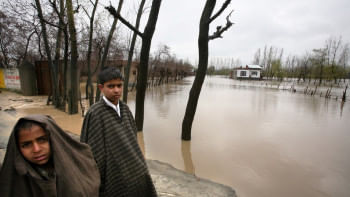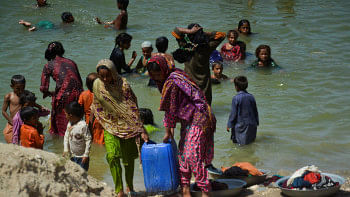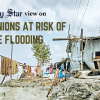Everything you need to know about the Loss and Damage Fund

The series of extreme weather events in 2022 fuelled by climate change that devastated lives and livelihoods of millions – from the floods in Pakistan and China to droughts in Somalia, Ethiopia, Brazil, and Europe – set a clarion call for the long-awaited climate finance, also known as loss and damage finance. After years of hard negotiations, at the world's global climate change platform last year, the 27th Conference of Parties (COP27), countries agreed to establish a fund to pay for climate-related losses and damages.
While this has given hope to many low-income countries that have felt the brunt of climate change, it has also left a lot of questions unanswered. What is the arrangement for this funding mechanism? Who will pay into the fund? Who is eligible?
Loss and damage finance decision at COP27
Loss and damage was the main topic addressed during the final negotiations at COP27, and the decision to establish and operationalise a loss and damage fund was one of the main talks around the halls. For nearly two weeks, the EU and the US refused demands from poor countries for a new fund to address loss and damage, arguing that existing funds should be redirected for the purpose. The final decision was adopted with the call from the EU to agree to a fund on condition that big economies and big emitters, who are still classed as developing countries under the rules of the United Nations Framework Convention on Climate Change (UNFCCC), should be included as potential donors and excluded as recipients.
The latest version of the Sharm el-Sheikh Implementation Plan "welcomes the adoption of decisions -/CP.27 and -/CMA.4, on matters relating to funding arrangements responding to loss and damage associated with the adverse effects of climate change."
Tracking of finance
Ever since the divergent decision at COP26, a number of countries and organisations have stepped up in making financial commitments. This bold step was initiated by the Government of Scotland, who initially pledged two million pounds towards addressing losses and damages, which then inspired the Government of Wallonia in southern Belgium and five more philanthropic organisations to put money for the cause. Since then, a few other countries and philanthropies have followed suit. It is, however, crucial to pinpoint the exact cause of each contribution, since not most of the pledges are for addressing losses and damages. The infographic summarises the monetary commitments from governments and philanthropies to loss and damage (note that the graphic only focuses on funds allocated to "address" loss and damage).
The Government of Scotland's contribution has been allocated for research among the climate vulnerable countries. The Government of Wallonia has allocated funds to ensure assistance for communities severely impacted by climate change. The Government of Denmark became the first central government of a developed country to propose funding devoted to loss and damage amounting to USD 17.7million, to be used for insurance and civil society efforts focused at the Sahel region in northwestern Africa. Likewise, Austria, another developed country, announced to provide USD 52 million to developing countries facing unavoidable damage and losses caused by climate change, in an effort to own up responsibility.
About USD 7 million will be managed by the Adaptation Fund, with the purpose of the Santiago Network and other ways to address loss and damage. Likewise, the World Bank Group has announced a Global Shield Financing Facility, a joint initiative launched by the G7 and V20 nations of Germany, Canada, Ireland and France, collectively funding USD 211 million allocated for disaster risk financing (social protection, government bonds, etc) to vulnerable countries. The Government of New Zealand has allocated USD 12 million over a period of three years dedicated to improving early warning systems and disaster risk insurance in the Pacific countries. The Children's Investment Fund Foundation (CIFF), the European Climate Foundation (ECF), the Hewlett Foundation, the Global Greengrants Fund, and the Open Society Foundation (OSF), among other organisations, have announced a funding of USD 3 million to strengthen resilience in climate-vulnerable countries.

Many countries and philanthropies have stepped up, but it is too little and too late. To usher in real change, as we move towards COP28 in Dubai this year, it will be necessary to develop a mosaic of funding channels both outside of the UNFCCC as well as under it to address loss and damage. The new funding mechanism under the UNFCCC must enshrine a genuine access to financial grants to the countries and communities most impacted, with a stringent monitoring and reporting framework, and ensure easy and fast financial assistance for risk management, rehabilitation, recovery and reconstruction efforts. The newly established Loss and Damage Fund can be used in a number of innovative ways to address loss and damage. It can be used for post-disaster rehabilitation and transition purposes, immediate case transfer and social protection, effective early warning systems, anticipatory action and emergency preparedness, and support to climate-displaced population.
But given the lack of finance available to support the action to address loss and damage, several innovative sources and mechanisms could be explored. Carbon taxes is one of the most logical approaches. The tax would raise money mostly from polluters under the principle of "Polluters Pay," while serving as an incentive to reduce emissions. A USD 2 levy on every tonne of carbon dioxide emitted from burning fossil fuels could add up to USD 50 billion a year. Likewise, a levy such as the International Air Passenger Adaptation Levy (IAPAL) is a proposed purchase tax on air tickets, the proceeds of which would be dedicated to investment in losses and damages. Another innovative mechanism is through the Bunker Fuel Levy, which is a unit tax linked to the establishment of an International Greenhouse Gas Contribution Fund that would collect a contribution on all ships over 400GT, differentiating according to the type of fuel used and proportional to the amount of fuel consumed. The private sector also has the potential to unlock the much-needed finance. Debt relief as part of an international finance architecture reform is another just mechanism to release finance for loss and damage efforts.
Key asks for COP28
The newly established Loss and Damage Fund represents a long and hard-fought win for developing countries and a vital step towards climate justice. The effectiveness of the new fund will be determined by the efficacy of raising ample capital and development of operational mechanisms that can respond rapidly and meet the urgent needs of communities. To crystallise the details of the fund, a "Transitional Committee" has been set up, with representatives from both developed and developing parties, which is expected to meet by March 2023 to flesh out the details and make recommendations for COP28.
While a lot of questions remain unanswered – mainly on who should be paying into the fund and who will be eligible to receive the funding – the Transitional Committee should iron out the fund details with utmost urgency, drawing on the lessons from humanitarian aids and the past climate finance mechanisms such as the Green Climate Fund and Adaptation Fund. The fund must be fit for purpose, and fit for any future climate-induced disasters with proper governance structures, accountability and transparency mechanisms to enable effective deployment to the ones who need it most on the ground. In addition, a fair and consistent valuation methodology should be developed in consultation with both affected communities and donor countries. And once this is in place, it is important to ensure knowledge-sharing and capacity-building of practitioners and communities to enable access and ensure that pledges can be distributed efficiently.
It is clear that the world has stepped into the era of loss and damage from human-induced climate change, and we need to collectively up our game to respond to the challenge. While the COP27 decision is welcoming and encouraging, this is only the beginning and, thus, success will depend on how quickly this fund gets off the ground. The funds should be set up by COP28 and be up and running by 2025. Failure to do so will result in an inevitable and catastrophic future for us all – the time to act is now.
Dr Saleemul Huq is director of the International Centre for Climate Change and Development (ICCCAD) at Independent University, Bangladesh (IUB).
Nusrat Naushin is coordinator of the Loss and Damage Programme at the ICCCAD.
Mimansha Joshi works as a consultant and is an advocate for climate change and environmental issues, and has authored a number of publications with the ICCCAD on topics related to loss and damage.



 For all latest news, follow The Daily Star's Google News channel.
For all latest news, follow The Daily Star's Google News channel. 










Comments